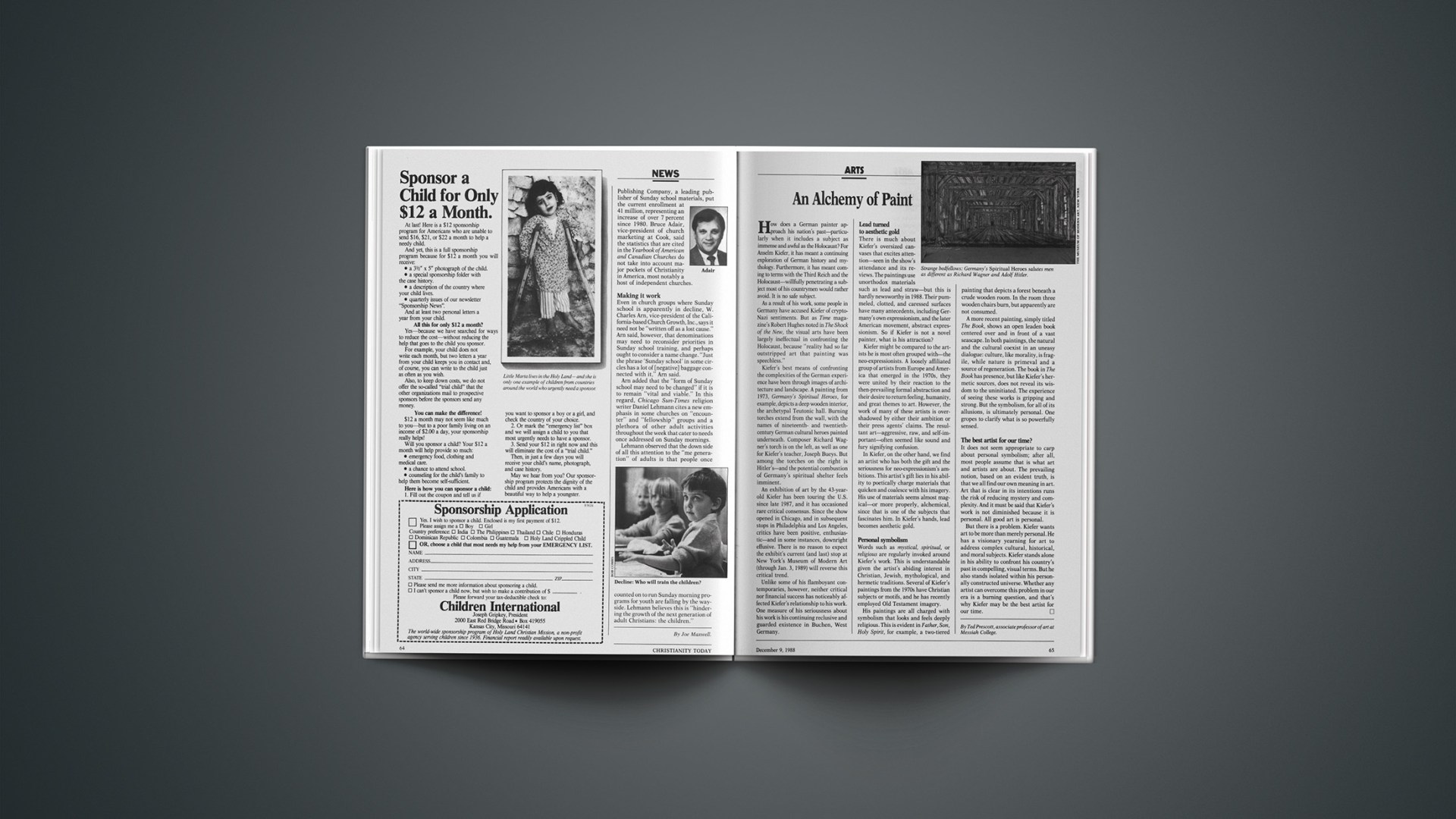How does a German painter approach his nation’s past—particularly when it includes a subject as immense and awful as the Holocaust? For Anselm Kiefer, it has meant a continuing exploration of German history and mythology. Furthermore, it has meant coming to terms with the Third Reich and the Holocaust—willfully penetrating a subject most of his countrymen would rather avoid. It is no safe subject.
As a result of his work, some people in Germany have accused Kiefer of crypto-Nazi sentiments. But as Time magazine’s Robert Hughes noted in The Shock of the New, the visual arts have been largely ineffectual in confronting the Holocaust, because “reality had so far outstripped art that painting was speechless.”
Kiefer’s best means of confronting the complexities of the German experience have been through images of architecture and landscape. A painting from 1973, Germany’s Spiritual Heroes, for example, depicts a deep wooden interior, the archetypal Teutonic hall. Burning torches extend from the wall, with the names of nineteenth- and twentieth-century German cultural heroes painted underneath. Composer Richard Wagner’s torch is on the left, as well as one for Kiefer’s teacher, Joseph Bueys. But among the torches on the right is Hitler’s—and the potential combustion of Germany’s spiritual shelter feels imminent.
An exhibition of art by the 43-year-old Kiefer has been touring the U.S. since late 1987, and it has occasioned rare critical consensus. Since the show opened in Chicago, and in subsequent stops in Philadelphia and Los Angeles, critics have been positive, enthusiastic—and in some instances, downright effusive. There is no reason to expect the exhibit’s current (and last) stop at New York’s Museum of Modern Art (through Jan. 3, 1989) will reverse this critical trend.
Unlike some of his flamboyant contemporaries, however, neither critical nor financial success has noticeably affected Kiefer’s relationship to his work. One measure of his seriousness about his work is his continuing reclusive and guarded existence in Buchen, West Germany.
Lead Turned To Aesthetic Gold
There is much about Kiefer’s oversized canvases that excites attention—seen in the show’s attendance and its reviews. The paintings use unorthodox materials such as lead and straw—but this is hardly newsworthy in 1988. Their pummeled, clotted, and caressed surfaces have many antecedents, including Germany’s own expressionism, and the later American movement, abstract expressionism. So if Kiefer is not a novel painter, what is his attraction?
Kiefer might be compared to the artists he is most often grouped with—the neo-expressionists. A loosely affiliated group of artists from Europe and America that emerged in the 1970s, they were united by their reaction to the then-prevailing formal abstraction and their desire to return feeling, humanity, and great themes to art. However, the work of many of these artists is overshadowed by either their ambition or their press agents’ claims. The resultant art—aggressive, raw, and self-important—often seemed like sound and fury signifying confusion.
In Kiefer, on the other hand, we find an artist who has both the gift and the seriousness for neo-expressionism’s ambitions. This artist’s gift lies in his ability to poetically charge materials that quicken and coalesce with his imagery. His use of materials seems almost magical—or more properly, alchemical, since that is one of the subjects that fascinates him. In Kiefer’s hands, lead becomes aesthetic gold.
Personal Symbolism
Words such as mystical, spiritual, or religious are regularly invoked around Kiefer’s work. This is understandable given the artist’s abiding interest in Christian, Jewish, mythological, and hermetic traditions. Several of Kiefer’s paintings from the 1970s have Christian subjects or motifs, and he has recently employed Old Testament imagery.
His paintings are all charged with symbolism that looks and feels deeply religious. This is evident in Father, Son, Holy Spirit, for example, a two-tiered painting that depicts a forest beneath a crude wooden room. In the room three wooden chairs bum, but apparently are not consumed.
A more recent painting, simply titled The Book, shows an open leaden book centered over and in front of a vast seascape. In both paintings, the natural and the cultural coexist in an uneasy dialogue: culture, like morality, is fragile, while nature is primeval and a source of regeneration. The book in The Book has presence, but like Kiefer’s hermetic sources, does not reveal its wisdom to the uninitiated. The experience of seeing these works is gripping and strong. But the symbolism, for all of its allusions, is ultimately personal. One gropes to clarify what is so powerfully sensed.
The Best Artist For Our Time?
It does not seem appropriate to carp about personal symbolism; after all, most people assume that is what art and artists are about. The prevailing notion, based on an evident truth, is that we all find our own meaning in art. Art that is clear in its intentions runs the risk of reducing mystery and complexity. And it must be said that Kiefer’s work is not diminished because it is personal. All good art is personal.
But there is a problem. Kiefer wants art to be more than merely personal. He has a visionary yearning for art to address complex cultural, historical, and moral subjects. Kiefer stands alone in his ability to confront his country’s past in compelling, visual terms. But he also stands isolated within his personally constructed universe. Whether any artist can overcome this problem in our era is a burning question, and that’s why Kiefer may be the best artist for our time.
By Ted Prescott, associate professor of art at Messiah College.










